The importance of stretching
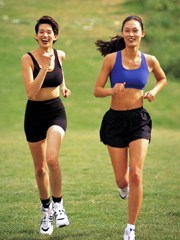
Muscle flexibility
Studies have found that regular stretching improves muscle flexibility. The flexibility of a muscle is its maximum range of motion around a joint. Increased flexibility has been shown to be associated with higher and longer jumps, and increased core stability and power. Having flexible muscles and joints helps decrease muscle stiffness and soreness which, in turn, prevents further injury.
Stetching to improve flexibility can be carried out at any time, not just before or after exercise. If you are going to stretch without exercising beforehand, make sure that your muscles are slightly worked or warm to prevent a strain or tear.
Tips for stretching
Although most exercise physiologists suggest stretching before and after exercise, the main benefits of stretching are obtained from post-exercise stretching. However, pre-exercise stretching is extremely important for sports such as dancing and gymnastics. Post-exercise stretching should start within 10 minutes of finishing exercise, before the muscles have a chance to tighten up.
Below are some important points to remember while stretching:
- Never stretch on muscles that have not been warmed up with at least 5 minutes of low intensity physcial activity.
- Stretch until you feel a “stretch” or tension. Muscles should never be strained to the point of pain.
- Hold post-exercise stretches for at least 30 seconds per stretch.
- Stretch slowly.
- Breath out at as you ease into the stretch.
Stretching examples
There are many common stretches that work the major muscles involved in exercise. Depending on the specific sport or activity you will be undertaking, you may need to focus more on different muscle groups. Your physiotherapist, coach or sports trainer will be able to recommend a stretching program suited to you.
Some common stretches are shown below.
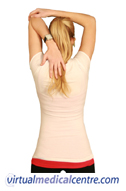 |
Tricep stretchStand up straight with your feet shoulder-width apart. Place your hand face down on your back with your elbow pointed toward the ceiling. With your other hand, lightly press down on your elbow until you feel a stretch underneath your upper arm (this is your tricep muscle). Repeat on the other side. |
 |
Calf stretchPlace both hands on a wall. Place one foot about a metre away from the wall, and use the other foot to steady yourself. Press against the wall with your hands. As you push, you should feel a stretch at the back of your lower leg. If you need a more intense stretch, place your foot further back. Repeat on the other side. |
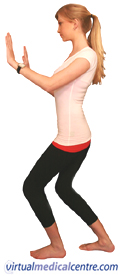 |
Gastrocnemius stretchPlace both hands on a wall. Place your feet hip-distance apart, one slightly closer to the wall and bent, and the other straight out behind. Press against the wall with your hands. A gentle stretch in the calf should be felt. |
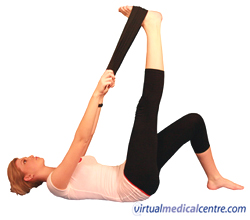 |
Hamstring stretchA theraband, towel or sheet is required. Lie flat on your back, making sure your stomach is tucked in to stop the lower back from arching. With one leg bent, point the other leg straight up so that the ball of the foot faces the ceiling. Wrap the theraband around the base of the upraised foot and pull on both ends until a stretch in the hamstring is felt. If a more intense stretch is required, straighten the bent leg. Repeat on the other side. |
 |
Quadricep stretchPlace one hand on the wall (or on your hip if you can balance). With the other hand, pull the same-sided ankle up towards your bottom until you feel a stretch in the front of the bent leg. If a more intense stretch is required, tilt the pelvis slightly toward the ceiling, but do not rotate laterally. Repeat on the other side. |
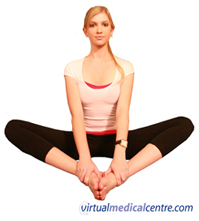 |
Groin stretchSit on the floor with the soles of your feet facing each other and knees flexed outward. Push both knees down to the floor until a slight stretch is felt in the groin. If a more intense stretch is required, bring the ankles closer to the groin and push the knees closer to the floor. |
| Stretch for the outside of the thigh | ||||
Step 1: Step into a stride stance with your problem leg forward. |
Step 2: Bring your weight forward onto your problem leg while keeping your back foot flat on the floor for support. |
Step 3: Push the hip of your front leg out to the side and hold position. You should feel a gentle stretch along the outside of your hip and upper thigh. |
||
 |
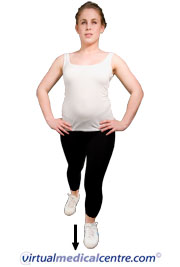 |
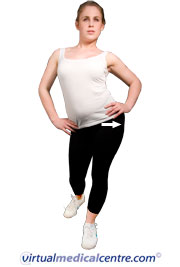 |
||
References
- Hoffman J. Physiological Aspects of Sport Training and Endurance. New Jersey: Human Kinetics; 2002.
- Brukner P, Khan K [eds]. Clinical Sports Medicine [3rd edition]. North Ryde: McGraw-Hill; 2006.
- Shrier I. Does stretching improve performance? A systematic and critical review of the literature. Clin J Sport Med. 2004; 14(5): 267-73.
All content and media on the HealthEngine Blog is created and published online for informational purposes only. It is not intended to be a substitute for professional medical advice and should not be relied on as health or personal advice. Always seek the guidance of your doctor or other qualified health professional with any questions you may have regarding your health or a medical condition. Never disregard the advice of a medical professional, or delay in seeking it because of something you have read on this Website. If you think you may have a medical emergency, call your doctor, go to the nearest hospital emergency department, or call the emergency services immediately.







